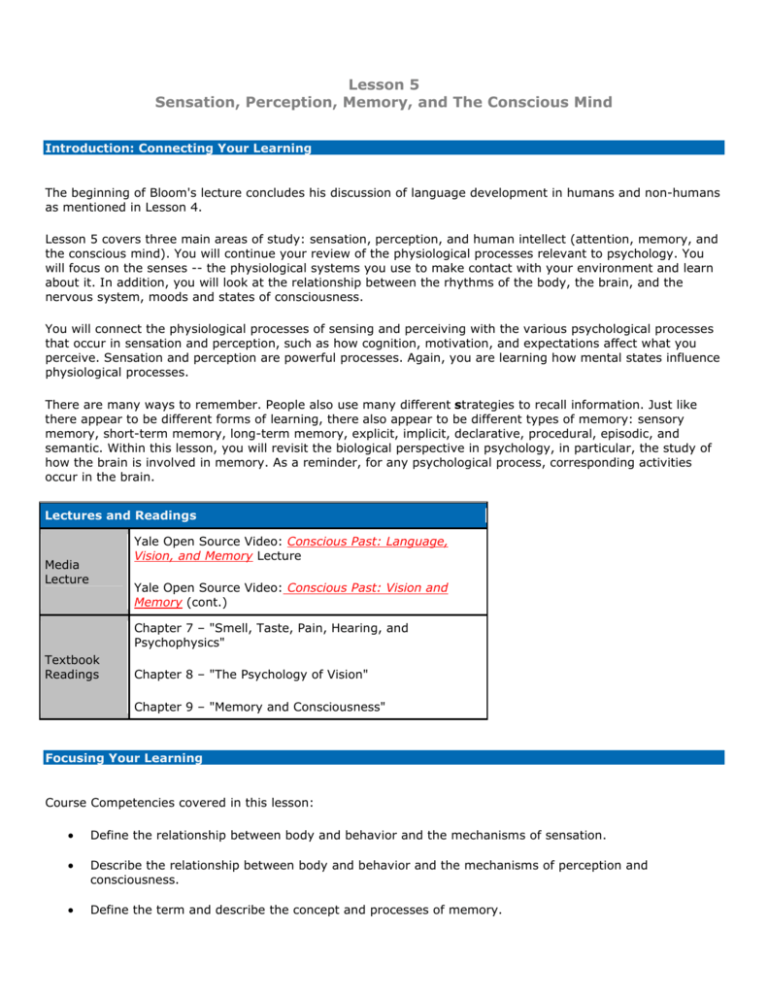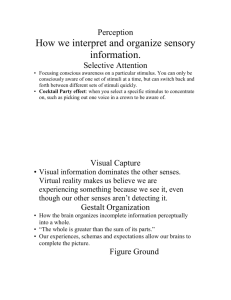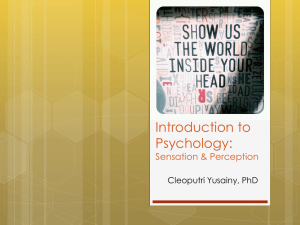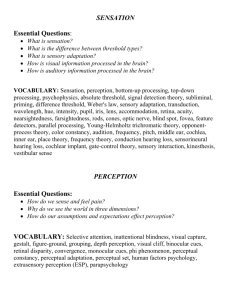Lesson 5 Sensation, Perception, Memory, and The
advertisement

Lesson 5 Sensation, Perception, Memory, and The Conscious Mind Introduction: Connecting Your Learning The beginning of Bloom's lecture concludes his discussion of language development in humans and non-humans as mentioned in Lesson 4. Lesson 5 covers three main areas of study: sensation, perception, and human intellect (attention, memory, and the conscious mind). You will continue your review of the physiological processes relevant to psychology. You will focus on the senses -- the physiological systems you use to make contact with your environment and learn about it. In addition, you will look at the relationship between the rhythms of the body, the brain, and the nervous system, moods and states of consciousness. You will connect the physiological processes of sensing and perceiving with the various psychological processes that occur in sensation and perception, such as how cognition, motivation, and expectations affect what you perceive. Sensation and perception are powerful processes. Again, you are learning how mental states influence physiological processes. There are many ways to remember. People also use many different strategies to recall information. Just like there appear to be different forms of learning, there also appear to be different types of memory: sensory memory, short-term memory, long-term memory, explicit, implicit, declarative, procedural, episodic, and semantic. Within this lesson, you will revisit the biological perspective in psychology, in particular, the study of how the brain is involved in memory. As a reminder, for any psychological process, corresponding activities occur in the brain. Lectures and Readings Yale Open Source Video: Conscious Past: Language, Vision, and Memory Lecture Media Lecture Yale Open Source Video: Conscious Past: Vision and Memory (cont.) Chapter 7 – "Smell, Taste, Pain, Hearing, and Psychophysics" Textbook Readings Chapter 8 – "The Psychology of Vision" Chapter 9 – "Memory and Consciousness" Focusing Your Learning Course Competencies covered in this lesson: Define the relationship between body and behavior and the mechanisms of sensation. Describe the relationship between body and behavior and the mechanisms of perception and consciousness. Define the term and describe the concept and processes of memory. Lesson Objectives By the end of this lesson, you should be able to: 1. Define sensation and perception. 2. Describe the basic mechanisms of taste, smell, hearing, and pain. 3. Explain Gestalt principles of perceptual grouping. 4. Define memory. 5. Identify the three types of memory stores and describe their functions. Approaching the Objectives Sensation Professor Bloom does not provide a lecture specifically related to Chapter 7 – "Smell, Taste, Pain Hearing, and Psychophysics." The concept of sensation is embedded throughout this course. However, you are responsible for reading the chapter and familiarizing yourself with the content. Sensation and perception are the foundation of knowledge and the source of all learning. Your contact and awareness of the environment begin with perception. The mysteries of the mind and consciousness first become apparent when you think about how your mind can be aware of the world around you. Consider this! In your own words, define sensation and perception. Gray describes three classes of events that contribute to the sensory process: Interaction with your external environment produces a response from your sense organs: eyes, nose, ears, tongue, and skin. Your sensory experience tells you something about the physical stimulus. You become aware of color, forms, odors, tastes, and sounds. The human brain organizes the sensory information and interprets or extracts meaning. The process happens so quickly, often during the earliest steps of organizing stimulus information, that you are not consciously aware of its fluid movement. Recall the processes of cognitive development in children from the previous lesson. Children learn by interacting with their environment. As explorers, babies put items in their mouths, turn their heads towards sounds, and look longer at bright colors. Your brain preserves relevant information about physical stimuli, referred to as sensory coding, and informs you of changes in your environment. Sensory adaptation occurs over time when a stimulus is unchanging or repetitious. You cease to recognize a particular smell, noise, sight, or taste. Consider this! Explore your environment. Can you identify a stimulus you have adapted to? The remaining chapter discusses the physiological responses and sensory experiences of smell, taste, pain, and hearing. Vision will be discussed in Chapter 8. As you read, consider differences in sensory experiences based on sex, culture, and in humans versus non-humans. After reading Chapter 7, answer the question below: Consider this! What would your world be like if you were unable to experience any external sensory stimulation? Be sure to include vision, hearing, taste, touch, smell, and pain in your discussion. The great philosophers from the West and the East pondered and considered the miracle of perceptual consciousness. Scientific psychology, in fact, grew out of the study of sensation and perception. To use a phrase from Leonardo da Vinci, the senses are "the windows of the soul." Perception Chapter 8 and Bloom's lecture introduce you to the psychology of vision. You will explore the structure and function of the eye, Gestalt's principles of perceptual grouping, and cues for depth perception. In the field of psychology, vision is studied more than the other senses. This chapter begins with the structure and function of the eye. Gray identifies five major components of the eye. You may be familiar with these terms: Component of the Eye See Figure 8.1 Location Purpose Cornea Front of the eyeball Helps focus the light that passes through it. Iris Behind the cornea Provides the color of the eye. Pupil Center of the Light passes through to the eyeball. iris Lens Behind the iris Adjusts when focusing on objects close or farther away. Retina Membrane lining the rear interior of the eyeball Contains the photoreceptors for vision. The cornea and lens bring light rays back together at a point on the retina, forming an upside down image. Consider this! Explain how the cornea, iris, and lens help form images on the retina. Your vision helps you to identify objects in your environment. However, your visual system does not function exactly like a camera. What you see is not always reality. According to Bloom, your perception of the environment is aided by unconscious assumptions. Your perception of color, objects, and depth is an interaction between physical elements in your environment and physiological processes. Your visual system organizes clues. Color: Trichromatic color theory – the retina contains three types of cones: red, green, and blue. The retina receives three different wavelengths of light. One cone reacts primarily to blue light (short wavelengths); another reacts to green light (medium wavelengths); and the third to red light (long wavelengths). The colors you see are a mixture of the three primary colors. Objects: Gestalt Principles of Perceptual Grouping – German psychologists in the early twentieth century started the Gestalt movement. Gestalt means "organized shape or form." A favorite saying of Gestalt psychologists is, "The whole is different from the sum of its parts." This statement emphasizes that the human mind organizes the world into whole, organized patterns and forms. Physiologically, your nervous system is naturally predisposed to respond to patterns in your environment. Below are the Kanizsa Triangle and Kanizsa Square Professor Bloom refers to in the lecture: Consider this! Review Gestalt principles of grouping on page 287. Explain two principles and how they help your ability to see whole objects. Depth: German physiologist Hermann von Helmholtz (1821-1894) was the first scientist to use the term unconscious inference. Depth perception allows you to infer the location of an object by estimating its distance and size. You rely on cues from your body and the external environment to supply you with information about space and distance. Images projected onto your retina are two-dimensional; however, your world is three-dimensional. Your mental processes work out the disparity automatically and quickly, without your awareness. Two classic examples of unconscious depth processing are the Ponzo illusion and the Muller-Lyer illusion. (See figure 8.41 on page 304 in your textbook.) Consider this! View View Joseph Campos-Visual Cliff Experiment Identify two activities you perform on a daily basis. Without depth perception how would you perform them? Memory Chapter 9 introduces you to a working definition of consciousness as one's awareness of self and the environment. Gray provides a broad definition of memory as "all information in a person's mind and the mind's capacity to store and retrieve that information." The study of memory will help you gain a much deeper understanding of the cognitive perspective. You will be able to see how the scientific method can be applied to the study of the mind, in particular the mental processes of attention, memory, and forgetting, and how your thought processes can affect the meaning and organization of the ideas and beliefs you acquire through life. You will see how the various cognitive processes within the human mind interact and affect each other. Bloom discusses each type of memory in depth, control processes, change blindness, and the process in which information moves from sensory memory to long-term memory. Memory ties directly into your processes of learning as discussed in Lesson 3. The three relatively simple learning types are habituation, classical conditioning, and operant conditioning. Bloom discusses the practical benefits of this lesson in your academic studies. Everyone can improve and develop their learning and memory skills. You can learn how to learn better and learn strategies for improving your memory. Bloom introduces you to the concept of attention, which is the process of moving information from the sensory memory to long-term memory. Attention is one of the control processes for transporting information. The other two processes are encoding and retrieval. View the view clip below on attention: Consider this! In his lecture, Bloom shows a video clip similar to the one below. Follow the class exercise as best you can as outlined in the lecture. View The Invisible Gorilla Optical Illusion Explain how you proceeded with the exercise. Bloom refers to the experiment on change blindness conducted by Dan Simons, a professor in the Department of Psychology and the Beckman Institute for Advanced Science and Technology at the University of Illinois. Consider this! View Change Blindness: you cannot be aware of everything After viewing the video clip, define change blindness and provide an example. The Big Questions! "How Do We Learn Better? How Do We Learn to Remember?" Rehearsal is not enough to move information into long-term memory. Bloom discusses the processes of encoding information into long-term memory, elaborative rehearsal, and then retrieval of such information through the use of retrieval cues. Bloom closes his lecture with a discussion on forgetting and memory failure. He discusses various theories on why people forget and cases of memory failure. The lesson concludes with a video clip of Clive Wearing, a man who has Korsakoff's syndrome, which is the inability to form new memories. Consider this! View Man without a memory - Clive Wearing [BBC - Time: Daytime] Can you imagine what your life would be like without memories? Think about it! Summarizing Your Learning Select Visual Illusions. To reinforce your learning, go to the PsychSim5 Web site. Once there, select Visual Illusions. You can review at your own pace by selecting the NEXT button to the right of the screen.






